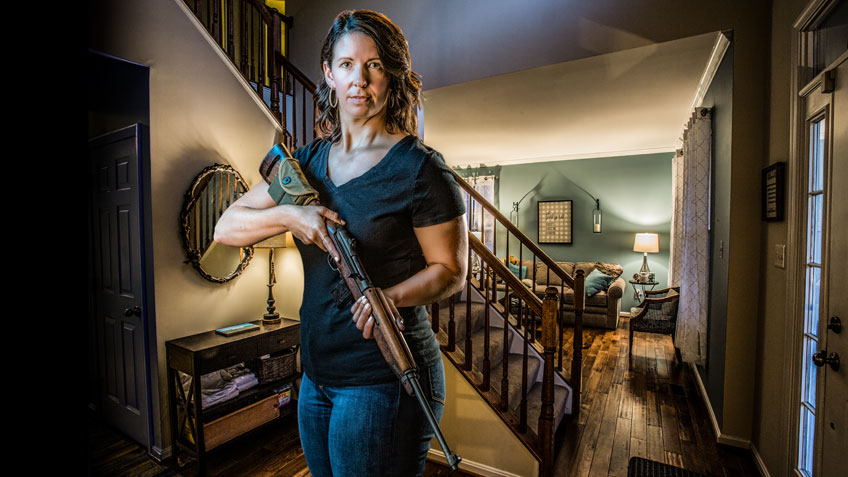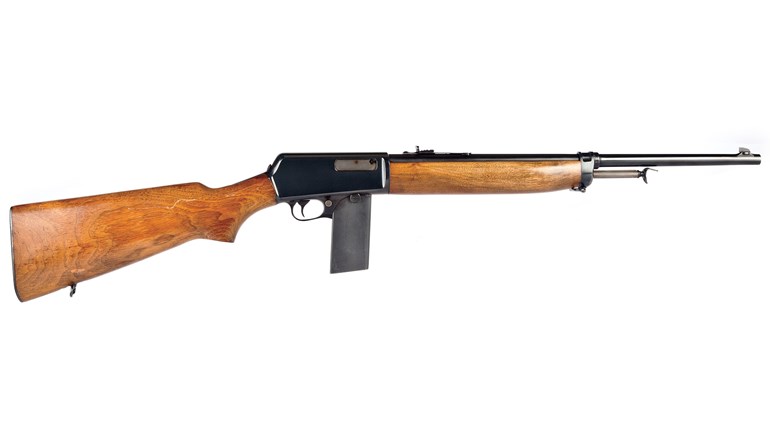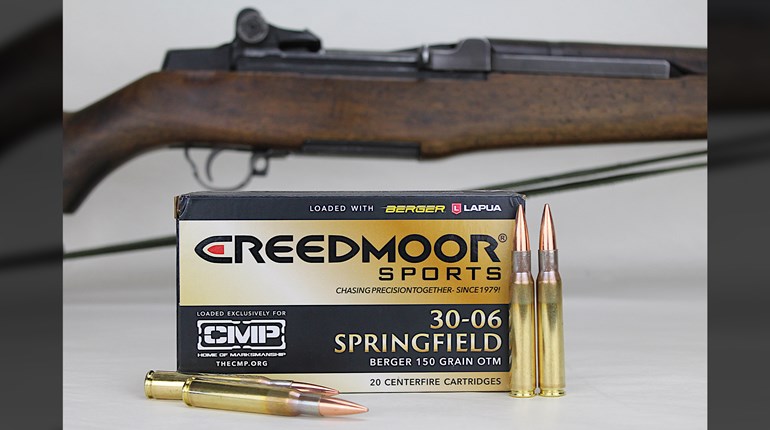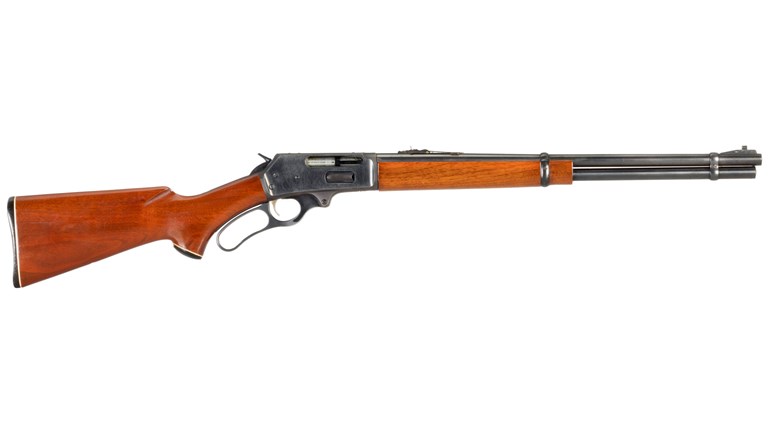
Despite all the atrocities of the Second World War, this global conflict gave our country’s fighting men and women some of the greatest individual battlefield weapons of the 20th century. While most of them have been retired from government duty by more advanced designs, these veteran World War II arms, like our Armed Forces veterans themselves, have attained a certain immortality, not only as symbols of America’s ongoing fight for freedom, but also as weapons still prized for their reliability and effectiveness.
Indeed, just as they have proven themselves on the battlefield, today these wood-and-steel World War II veterans—collectability aside—can serve in an even more personal mission of protecting our homes and families. To validate this concept, I enlisted the opinions of some of the most skilled and experienced firearms and self-defense experts I know: the instructors of Gunsite Academy.
Gunsite’s Ken Campbell, who spent more than 35 years with the Boone County Sheriff’s Office in Indiana before he retired and relocated to Arizona, has a sizable collection of World War II firearms, including the favorite World War II vet for home defense among Gunsite instructors—the M1911 pistol, a gun with a well-deserved reputation.
“I was a young and wet-behind-the-ears USAF Airman on my first deployment to Central America, assigned to the U.S. Army’s 82nd Airborne,” says Gunsite instructor Daniel J. Bilodeau, who was deployed to Joint Task Force Bravo in 1986, after which he began a 30-year career as a Federal Agent with the U.S. Department of Energy. “My first meeting with my platoon sergeant,” he recalls, “I showed up in my issued gear and he took notice of my USAF-issued Smith & Wesson Model 15 .38-caliber revolver. His comments still ring in my ears with a tone of dissent: ‘You need to take your ass to the armory right now and tell them I said to give you a 1911. We tried that .38 crap before and it didn’t work out too good back then, and I don’t see how it would be any different now. I’ve seen that .45 work and have no doubt it will still work now.’”
Gunsite instructor Jerry McCown, a retired Arizona law enforcement officer with 41 years of service, has additional reasons to prefer the 1911 as a home-defense tool.
He points out that, “…with only a .45 ACP casing, you can completely disassemble the firearm, fieldstrip it, remove the safety, use the pivot pin on the safety to punch out the mainspring housing pin, use the trigger/sear/disconnector leaf spring as a screwdriver to remove the magazine release and you only need the .45 ACP casing rim if you wish to remove the stocks…A homeowner can easily disassemble and completely inspect a military 1911 without outside assistance. The more modern 1911s are not so forgiving.” McCown added that while modern, tricked-out 1911s offer a lot of accuracy-improving features, they may not be necessary: “How accurate does a home-defense pistol need to be when the distances are usually well within 30 feet?”
Gunsite Range Master John Hall shares McCown’s admiration for the 1911. “I carried one in Iraq, as well as a duty weapon for law enforcement,” recalls Hall, who served 8 years as an infantryman with the U.S. Army and National Guard. “I also carried a 1911 for several years as a full-time police officer in the U.S. I have always felt comfortable carrying that handgun and have never felt that the gun was obsolete. What I have always told people regarding the 1911 is to stay away from excessive customization, make sure it is reliable, has a good trigger and sights you can use.”
Retired Jefferson County, KY, Deputy Sheriff Chris Edwards, a Gunsite Instructor and Match Coordinator, also favors the stock 1911. “The 1911 in near ‘mil-spec’ form in trained hands is a formidable home-defense handgun, especially when coupled with a flashlight,” he says. “It’s a legend in close-quarters combat, and reliable, if one hasn’t [messed] with it. I have on two occasions confronted home intruders with one, and I was glad I had it.”
It is interesting that McCown, Hall and Edwards all caution against over-customizing the standard Government 1911 for home defense. From personal experience, I can state the as-issued M1911 and the M1911A1 are more than up to the rigors of Gunsite’s fast-shooting defensive training exercises, as I have taken both versions of these slab-sided semi-automatics through the Academy’s courses. These are stock mil-spec guns, with no lowered ejection ports, no extended beavertails and no polished ramps. I encountered nary a malfunction. Of course, using top-grade ammunition, such as Black Hills’ 230-grain JHPs, DoubleTap’s 185-grain Bonded Defense HPs or Hornady’s Critical Defense 185-grain FTX, help John Browning’s old war horse function most effectively. The only criticism I have of the 1911 is its relatively shallow sights, which, for me at least, make quick acquisition difficult.
Although the Government Model 1911 was America’s primary military sidearm during World War II, two revolvers—the Colt New Service and the Smith & Wesson Hand Ejector—also played crucial roles in helping fill the urgent need for handguns immediately following the bombing of Pearl Harbor, and thus, given their .45 ACP chamberings, are well-qualified as home-defense guns today. Confusingly enough, however, in their military garb, both guns had been given identical nomenclatures of “U.S. Model 1917,” and both were originally drummed into service during World War I as blued guns. However, World War II brought them back with Parkerized finishes, in the same .45 ACP chambering as their predecessors. Even surplus World War I guns called back to duty were refinished with Parkerization before heading off to war. As Bruce Canfield notes in his authoritative book, “U.S. Infantry Weapons of World War II,” most of these were issued to Military Police and stateside units, but approximately 21,000 Model 1917s saw combat in Europe and the Pacific.

“I’ve got a USGI Colt New Service, a Smith & Wesson 1917 and I remember a Smith & Wesson 1917 with its barrel cut to 4 inches being carried on duty by an old town marshal in my county,” Campbell recalls.
Of course, being chambered for the rimless .45 ACP meant these revolvers had to use half-moon clips to facilitate ejection of spent cases. Today, with full-moon clips or .45 Auto Rim ammunition, both the Colt and Smith & Wesson Model 1917 revolvers have become even more practical as home-defense pistols, although +P ammunition is not recommended for these old-timers.
“I carried revolvers as a deputy in the last century and can’t recall a failure,” says Edwards. “In the extraordinary event of a failure to fire, pull the trigger again. [As far as military revolvers], I’ve shot a Smith & Wesson .45 ACP in competition. Powerful and easy to control, reloads (with full-moon clips) are faster than any other [type of revolver].”
Hall also sees the home-defense value of these military wheelguns. “Revolvers may not have the current appeal of semi-automatics,” he says, “but they remain an effective tool.”
But, sometimes in a home-defense situation, you may have to use something more effective than a handgun. That’s where the purpose-built, cylinder-bore, 12-gauge military shotgun—or trench gun—comes into play. Indeed, these pump-action scatterguns got favorable comments from Gunsite’s cadre as a defensive tool.
“There is no question that a pump gun is seen as a near-ultimate defense firearm,” says Edwards. Hall is equally succinct. “The ability to put multiple pellets on a target with a single press of the trigger can help to decisively end a person’s bad intent,” he says.

The most prolific World War II trench gun is the Winchester Model 97. But, the Winchester Model 12, the Remington Model 11 and the Ithaca Model 37 are just a few other World War II vets to be considered. It should be noted that the Ithaca Model 37, with its World War II blued finish, is the rarest, with only 1,422 produced. You will have a better—and more affordable—chance of acquiring a post-World War II Parkerized version of this gun, which is almost identical.
Gunsite Instructor Lew Gosnell, a former Marine MP and police firearm instructor, is a big fan of the Ithaca Model 37. “The Ithaca 37 is an extraordinary gun,” Gosnell says. “I currently own two police-service surplus Ithaca 37s. Both are 2¾ -inch chambered guns, with rifle-style sights and four-round magazines. One is a New Mexico State Police stamped gun, with that agency’s markings on the receiver. My other Model 37 was stamped HPPD by my last employer, the Huntington Park Police Department. [They are] remarkably reliable and lightweight shotguns, considering their walnut and steel construction.”
Another one of my favorite World War II home-defense guns is the M1 carbine. Although sometimes slighted for its .30-carbine chambering, it is fast-handling, recoil is minimal and with its 18-inch barrel is compact enough to store under the bed, especially the M1A1 folding-wire stock variant, originally manufactured for paratroopers by the Inland Manufacturing Division of General Motors.
“My first ‘patrol rifle’ as a young deputy was a surplus M1 Carbine,” says Campbell, who recalls other deputies carrying M1 carbines as well. “I even remember one of the deputies had a [pistol-gripped] M1 affixed to the door of his car,” he says, possibly referring to the M1A1.

Making the M1 carbine even more viable for self-defense, the oft-chastised FMJ rounds of World War II have given way to much more effective loads, such as Hornady’s Critical Defense 110-grain FTX load and—if you can find a box because of its limited production—Federal Premium’s excellent Power-Shok 110-grain softpoints.
At this point I’d like to give the M1 Garand a nod, especially after seeing Clint Eastwood with one in the 2008 movie “Gran Torino.” Yes, at 9.5 pounds it is a little hefty, but for home defense, portability is less of a concern. It remains an outstanding defensive rifle, although more modern options like the AR-15 offer significant advantages over the old Garand. If you’ve got a Garand, however, it can be an effective tool for home defense.
“My introduction to the M1 Garand was as range master and armorer for the police department,” says McCown. “I had requested the department purchase a group of these rifles for situations that required precision shots.”
Of course, unlike the other firearms described here, the Garand, with its .30-’06 Sprg. chambering, was not designed for close-range use and is fully capable of penetrating multiple walls and even dwellings, so extreme caution is advised when considering it for home defense. Always follow the safety rules with this or any other gun, but knowing what is beyond your target is particularly important if using a Garand for home defense.

“The mighty M1 Garand certainly has power,” says Edwards, “and a trained shooter could be very effective at distances, say on a farm or ranch. I am not sure it would be my first choice in an apartment or condo, but it would certainly do if used intelligently. After all, the first rule in a gunfight is to have a gun.”
That, of course, may be why the Army chose to arm many of its general officers, as well as OSS agents, the Military Police and others, including some Transportation Corps personnel, with 1903 and 1908 Colt Pocket Hammerless pistols in .32 ACP and .380 ACP, respectively. Most were Parkerized and all were stamped “U.S. Property” on the right side of their frames. While highly collectable, these little semi-autos—especially when loaded with today’s more potent fodder like Black Hills’ .380 ACP Honey Badger 60-grain load—can serve as effective defensive handguns and are more concealable than a 1911.
“Just because a gun has been around awhile and may be considered ‘old’ does not mean it is no longer adequate as a defensive firearm,” says Hall. “The steel and wood finishes may not have the flash or modern mass-production characteristics of some of the currently popular firearms, but you can take any of these ‘antiquated’ guns and be well served in your ability to protect yourself and your loved ones.”





































